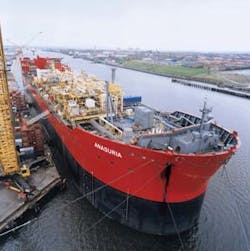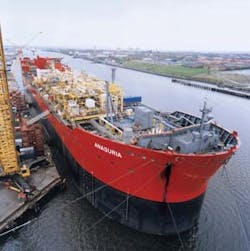Offshore Europe
Hydro weighs up options for Fram
Two sizable discoveries have been reported by Norsk Hydro in the Norwegian North Sea. Both are within tie-back distance of the Troll complex facilities to the south. However, with a clutch of other undeveloped structures nearby, Hydro may have to consider a separate standalone development.Exploration well 35/11-8S was drilled in 360 meters of water, northwest of two adjacent oil and gas structures known as Fram and south-east of an untouched gas condensate discovery. It tested oil and gas within several Jurassic horizons, with maximum flow test rates of 4,400 b/d and 2.7 mcf/d through a 3/4-in. choke.
A block further northeast is the Gjoa oil and gas structure. Just to the east of this, well 36/7-1 tested oil at 6,447 b/d and gas at 6 mcf/d through a 1-in. choke. Based on these preliminary findings, UK analyst Wood Mackenzie puts Fram area reserves at 160 MM bbl and 700 bcf, and those around Gjoa at 100 MM bbl and 700 bcf.
Hydro's dilemma is whether to tie Fram back to the second FPS planned for the Troll Oil expansion project, or to develop Gjoa subsea through another FPS on Fram. There is scope for further finds close to Gjoa. Assuming development goes forward at all, with no spare capacity on the Troll Oil export line, a new pipeline would probably be needed.
Statoil also hit gas with an exploration well in block 34/11, east of Gullfaks. Drilling in 261 meters of water, gas and condensate were encountered in Middle Jurassic (Brent) sandstones: the estimated 500 bcf could perhaps be accommodated on the newly upgraded gas handling facilities on the Gullfaks C platform.
From the same installation, Statoil has just drilled what is billed as the world's first short-radius side-track, at a depth of 4.5 km. Dogleg severity (in well 34/10-C-20A) was 42 per 30 meters. Screens were then due to be installed to prevent sand production, set in oil-based mud.
Wadden Zee drilling on hold
A court in Leeuwarden, The Netherlands, has suspended four of NAM's five drilling licences in the Wadden Sea. Drilling restrictions had been lifted on the region after a moratorium of several years, but the court ruled that the Ministry of Economic Affairs had not properly assessed the negative environmental impact of NAM's program. This had been scheduled to start last month using the rig Ensco 72.
NAM must now submit a further environmental study before the court rescinds its decision. The operator is proceeding with development of the K/14B gasfield in a less sensitive part of the North Sea, a $45 million development involving a single-well tieback to an existing platform and a new horizontal well. This is due onstream October 1997, peaking at 2.4 mcf/d.
Of the other players left on the Dutch shelf, Occidental has suspended well L/11-A2 as a gas discovery. But BHP has sold most of its Dutch field assets to Dyas, apart from its operating interest in block G/17c. The sale includes 7.25% of Elf's K/4b-K5a license, one of the most prospective areas remaining off The Netherlands. The deal also puts Dyas into the top ten of Dutch shelf asset owners.
Irish oil two steps nearer
Ireland's minuscule offshore production sector could soon be swelled by two oilfield developments. Dublin zinc mining group Arcon is scouting for partners to develop Helvick, an old oil discovery in the Celtic Sea off Waterford. Up to 5 MM bbl are thought recoverable, in waters 4350 ft deep.
Connemara, in Porcupine Basin Block 26/28a off west Ireland, may hold ten times more oil; but until Statoil's takeover of operator Aran Energy last year, neither the resources nor the technology were in place for the development. Water depth is 300 meters.
Statoil UK has now initiated a new 3D survey of the field through Geco Prakla's Seisquest vessel. The data, with reprocessed 2D seismic, will be used to determine the site of a new well to be spudded next March on the field by the semi JW McLean (ex-Rig 42). The rig will then be used for an extended well test, with options for further appraisal drilling over a period of up to 19 months.
Chevron and Statoil also plan further surveys in the vicinity of Connemara this summer, with Geco lined up for 1,100 km of 2D seismic in Statoil's 5/94 license.
Pipeline eases oilfield congestion
Shell, Esso, Amoco, and Amerada Hess are funding a new £75 million pipeline from Shell's Fulmar platform to the Phillips Norpipe system. Allseas is installing the 16 km, 24-in. diameter line, due to be operational next January. It will also handle output from other Shell-operated fields in the UK Central North Sea - Gannet and Auk - and likely BP's Clyde Field, too.
Until now, oil from these fields has been exported through a leased tanker loading system using Statoil's storage vessel Vinga. But Shell and co. faced a steep bill for servicing or conversion work on the tankers. Instead they opted for the new line, which will have initial capacity of 140,000 b/d.
Shell has numerous other new developments coming forward throughout the North Sea. The first to produce oil will be the Teal, Teal South, and Guillemot Fields in late August. Production will be through a newbuild vessel, the Anasuria, due to leave Amec's yard in northern England shortly.
Later this year Mallard, another oilfield in the Central North Sea (block 21/19) could undergo development as a subsea tieback to the Kittiwake platform 18 km to the west.
The newly converted FPSO Anasuria at Amec's yard in Tyneside, UK, should leave shortly for duty on the Teal, Teal South and Guillemot development.
Further FPSOs under review
Elsewhere in the UK North Sea, engineering design contracts have finally gone out for Marathon's West Brae subsea tieback to the Brae A platform, and Elf's Elgin and Franklin high pressure, high temperature gasfield developments. The TPG 500 jack-up platform is a strong contender here for the production role.
Preliminary studies are also underway for three fields which are candidates for floating production. McDermott is analyzing Kerr-McGee's Janice oilfield in UK block 30/17a; and Victoria Oilfield Development is thought to have been contracted for an extended well test on Texaco's Mariner heavy oil discovery, using a semisubmersible.
Mariner would not be onstream likely until 1999, but another Texaco Field, Galley, could start up late next year. Odfjell Drilling is performing the FEED work, with semisub Chris Chenery expected to form the hub of the development.
In Norway, Esso is considering three development options for its Elli, South Elli and Tau Fields, thought to contain 200 MM bbl in total. These are an FPSO with subsea wellheads; an FPSO linked to a wellhead platform; and a WH platform tied back to a new processing platform on Elf's Heimdal Field, 15 km away. The development would be named collectively Jotun, with first oil possible late 1998 or early 1999, peaking at 80,000 b/d.
Copyright 1996 Offshore. All Rights Reserved.

